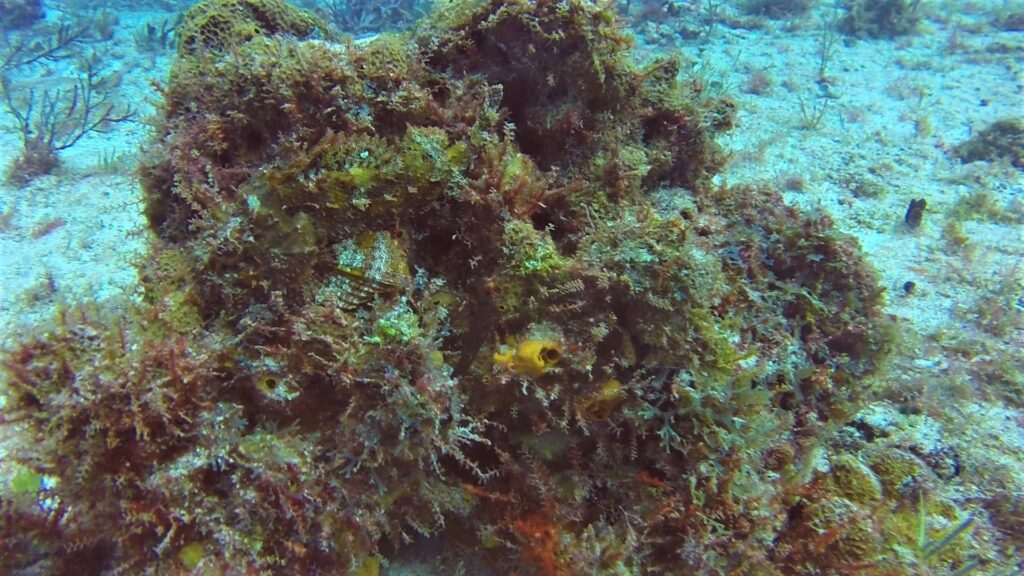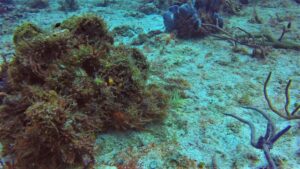It is a beautiful sunny day. “El Caribe” is as smooth as glass. The boat has left the pier and is cruising south to your favorite dive site. Your anticipation and excitement build as the divemaster signals for you to start gearing up. You back-roll into the crystal-clear aquamarine water. After an hour of effortless drift diving, you return to the boat. The boat is buzzing with discussions of amazing coral formations, swim-throughs and the color and beauty of the reef – angelfish, parrotfish, triggerfish, barracuda, schools of grunts and jacks, sting rays and turtles. But, what did you miss? There is so much more to see if you shift your focus. Take some time to look for the small and not so obvious reef creatures.
One of those is the spotted scorpionfish (Scorpaena plumieri). The term scorpionfish refers to a group of ray-finned fishes (Class – Actinopterygii) in the family Scorpaenidae. The ray-finned fishes include over 20,000 species with rays or spines in their fins, as opposed to lobe-finned fishes with fleshy fins (i.e. coelacanth and lungfish). Members of the Scorpaenidae family are divided into 3 groups, which include lionfish, scorpionfish and stonefish and are among the most venomous fish in the world. This family of fish is second to the stingray for the most marine envenomations annually.
Have you spotted me yet? No? Click on the image below and you’ll see me appear.
The spotted scorpion fish is a bottom dwelling master of disguise, which is camouflaged to look like rocks or coral. This is the result of their coloring and texture. Their color is commonly a mottled mixture of gray, brown, red and black. It has 12 dorsal spines, 10 soft dorsal rays, 3 spines on the anal fin, 5 anal soft rays, 2 spines on the pelvic fins and pectoral fins with well-developed rays. Their pelvic fins have been adapted to allow them to “walk” on the ocean floor. Markings include three dark bars on their tail. The inside of their black pectoral fins has white spots, which is where they get their name. The spots are only displayed when the fish extends its pectoral fins because it feels threatened or when it is swimming. Adding to their camouflage are fleshy plumes (cirri) over the eyes and around the head and chin. Scorpionfish also have the ability change color to better match their surroundings. All of this helps them blend into the reef or rocky bottom and makes it easy for them to go unnoticed by divers and predators alike. Because they lie motionless for long periods of time, it leaves them susceptible to parasites (algae, bacteria and crustaceans), which they get rid of by shedding their outer layer of skin. Although they can charge quickly, they are not aggressive and prefer to hide or swim away. They typically lie motionless and camouflaged on the bottom, where they rely on their “invisibility”. This makes them easily approachable by divers.
The spotted scorpionfish is a nocturnal predator and spends most daylight hours resting on the reef. As an ambush predator, the spotted scorpionfish lies camouflaged and motionless waiting for its prey to get within range. They have a wide mouth used to swallow prey whole. They feed on fish, crabs, shrimp, octopods, other mollusks and invertebrates – basically any animal that will fit in their mouth. By quickly opening its large mouth, it creates a vacuum, pulling in water and dragging the prey with it. This all happens in fractions of a second. Unfortunately for the scorpionfish’s unsuspecting prey, they likely do not know or see what is coming, until it is too late.
Scorpionfish are oviparous. Eggs and sperm are released during spawning. Females release 2,000-15,000 eggs that are transparent or greenish colored. The males and females return to the reef and the fertilized eggs float to the surface, where they are less likely to be eaten by predators with a taste for scorpionfish caviar. The eggs hatch in 2 days. Do you know what they call these hatched baby fish? A fry, sound delicious? Scorpionfish fry remain near the surface until they reach approximately 1 inch. They then swim down to become part of the reef community. The lifespan of the spotted scorpionfish is up to 15 years.

Thanks to Ron Knafla for this very
educational article on Scorpionfish.



